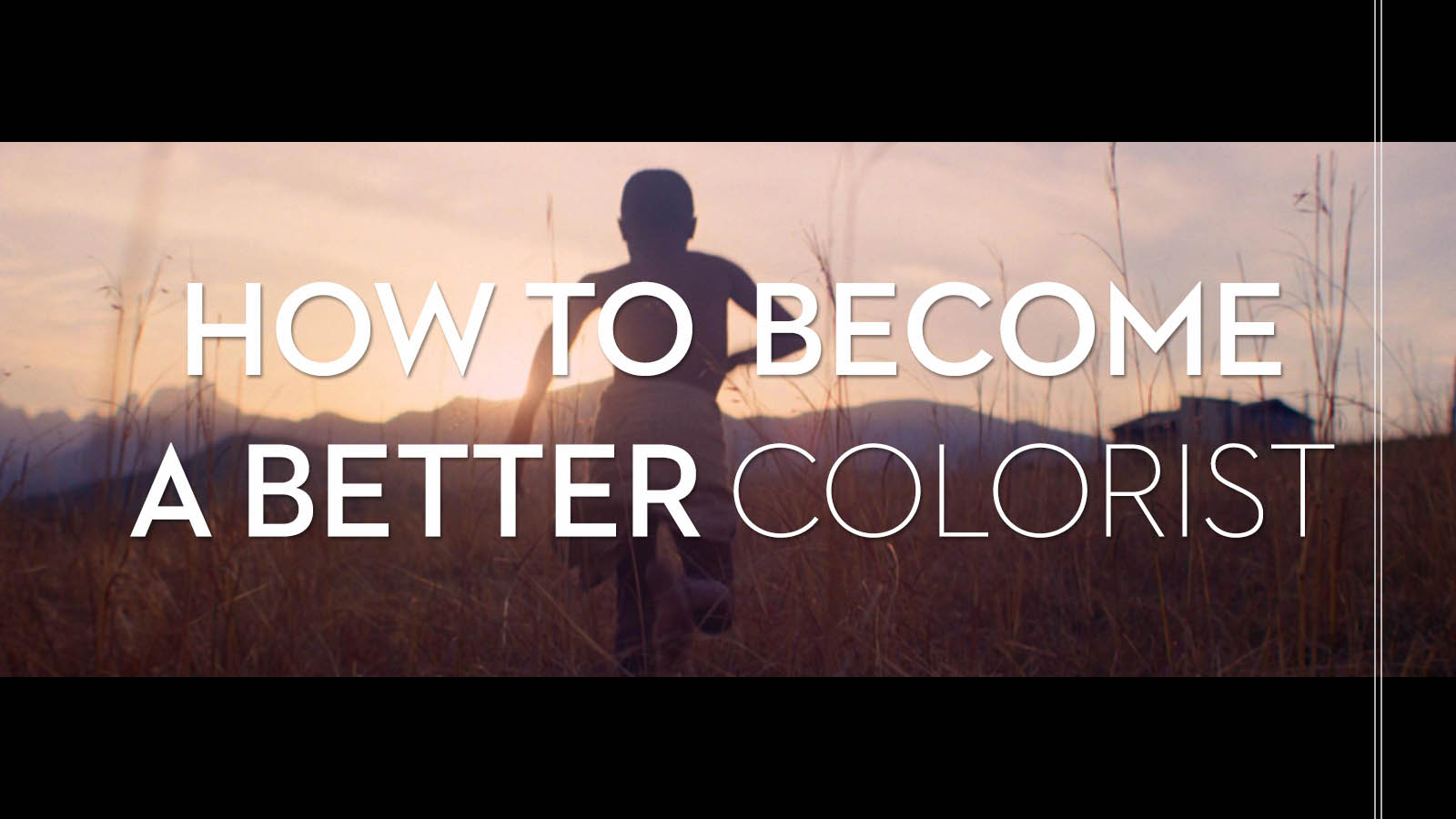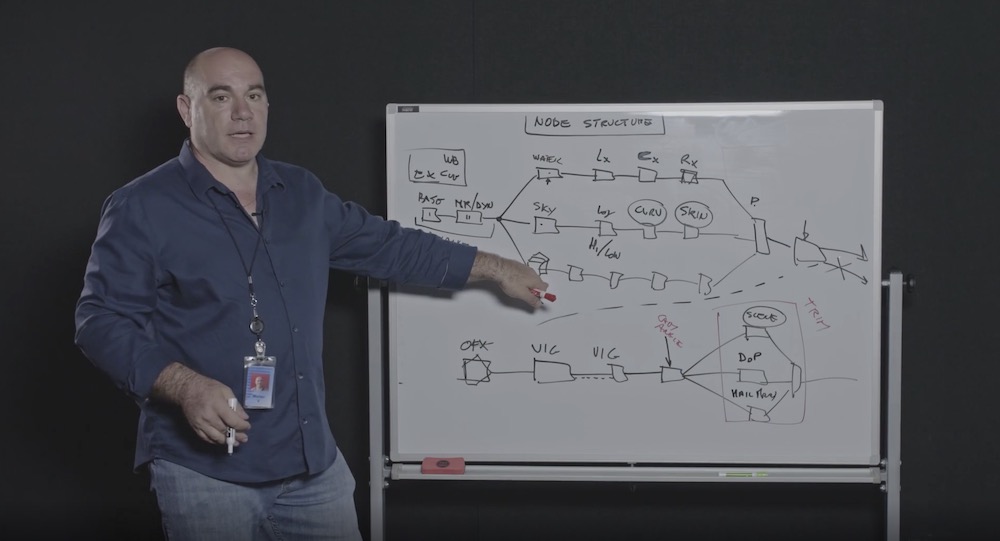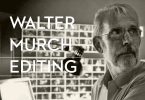How to Become a Better Film Colorist

This is how to become a better colorist; grade everything you can and learn from more experienced colorists whenever you can.
In this post I’ll share some of the best resources I’ve found over the years to help you learn more about the art, craft and business of colour grading direct from some of the world’s most influential colorists.
This includes the best colorist training and community sites you should consider subscribing to for your professional development, as well as interviews with the following colorists:
- Stephen Nakamura (News of the World, Da 5 Bloods, The Martian)
- Dado Valentic – Colorist and creator of AI driven grading software Colourlab
- Ian Vertovec (Gone Girl, Tales from The Loop, GLOW)
- Andrea Chlebak (Elysium, Mandy, An American Pickle)
- Steve Scott (The Mandalorian, Roma, Bad Times at the El Royale)
- Dave Hussey (Company3) – Many high-end music videos, commercials and even films
- Lynnette Duensing – Trailer colorist – Greyhound, SpiderMan:Into the Spider Verse, Men in Black International and many more!
I’ve raided this popular but outdated post from 2015 for some of these resources, as well as tried to highlight other places on the blog you can go for even more insights from experienced colorists.
Key previous posts featuring interviews with professionals colorists not to miss include:
Interviews with Film Colorists – Including a fantastic interview series with colorist Mike Costa
Learn Color Grading from Professional Colorists – Scroll to the bottom for some amazing free talks from colorists including Mindhunter colorist Eric Weidt and legendary colorist Peter Doyle and more!

This recent post featuring highly sought after feature film colorist Walter Volpatto has proved to be very popular, as it highlight’s his technique of using a fixed colour grading node structure to grade feature films such as Star Wars: The Last Jedi, Dunkirk, The Hateful Eight, Interstellar and many, many more.
Working with a fixed node structure means that Walter applies a pre-built set of nodes to every single shot in the project – before he makes any colour corrections at all – so that he can stay organised and efficient whilst handling the most demanding projects.
Walter’s presentation is part of LowePost’s Insider series which features specific techniques like this, and as such is behind their very affordable paywall, but his answers to viewer questions are not, so I’ve gathered the best of those in this post too – so do check it out!
Learn to Grade like a Professional Colorist
If you’re looking for actual colour grading courses that are taught by professional colorists then you’re in luck as there are a fair few to choose from in today’s world.
Here are my top recommendations:
LowePost.com – Has a growing collection of short colour grading courses featuring industry leading colorists such as John Daro (featured above), Chris Jacobson and Derek Hanson, with more in the works, including Look creation and Matching in DaVinci Resolve with colorist Jason Bowdach and two classes from colorist Marc Wielage.
LowePost also has numerous really helpful courses targeted at learning critical techniques in DaVinci Resolve/Fusion such as:
- Beauty Retouching in DaVinci Resolve Fusion
- Paint Fixing in DaVinci Resolve Fusion
- Conforming in DaVinci Resolve
- Colour Management in DaVinci Resolve
This post on Learning High End Finishing Techniques in DaVinci Resolve Fusion also covers each of the courses available on LowePost.com in more detail, along side a host of other free tutorials for anyone looking to provide their clients more value through learning DaVinci Resolve Fusion.
MixingLight.com – Colorist Community and Training Library – An excellent source of consistently fresh insights and detailed training (with over 600 video tutorials!) from highly experienced colorists as well as a fantastically supportive global colour grading community.
I have compiled a complete list of every single free ‘Insight’ from Mixing Light.com that is in front of their paywall here.
If you’re a professional colorist, or want to be one, then a subscription to both LowePost.com and MixingLight.com will prove invaluable!
Mad Max: Fury Road Colorist Eric Whipp’s Color Grading Secrets on FilmmakerU
I really enjoyed colorist Eric Whipp’s colour grading training course on FilmmakerU.com, and you can read my detailed review of it here, because he genuinely teaches you things that could prove transformative for your colour grading career.
One thing that I learned very early on as a colorist, which has changed for me dramatically the way that I work as a colorist is that it’s almost crucial that you narrate your work as you’re working.
It seems strange when you’re working but you need to be working on a shot saying “How’s this? This is a little bit more saturation? Here’s before and after.” You’re talking throughout the whole process.
Because, I didn’t realise until after a few years of doing this, that I sat in another colorist’s room, one day. And it was my first time experiencing what it’s like to sit with a colorist. I was always the colorist. How do you know what it’s like to be in somebody else’s session?
And this particular session was interesting because the colorist didn’t really talk. He did a great job… but if you’re sitting there watching something very slowly change across the screen, it’s imperceptible.
The colorist knows and he can tell that things have happened, but if you don’t discuss it and talk about it, it’s the most frustrating thing. Is this more blue? I don’t know! You haven’t explained it.
It’s very important to walk every body through the process… the major decisions need to be done interactively.
– Eric Whipp
If you want to learn more about how Eric colour graded the iconic Mad Max: Fury Road then check out the rest of my review, which also includes a really great interview with Eric by Gordon Burkell from Filmmaker U.
Also be sure to enjoy this massive round up of resources on the making of Mad Max: Fury Road too.
The team behind Filmmaker U were generous enough to offer my readers 10% off each of their courses with the following discount codes:
- Colorist Eric Whipp = JONNY
- Sound Designer Eugene Gearty = 3UG3NE4J0NNY (the o is a zero)
- Editor Brian Kates = BR14N4J0NNY (the o is a zero)
FXPHD – Kevin Shaw’s Introduction to HDR
London based colorist Kevin Shaw delivers an introduction to colour grading in HDR in this new 7+ hour course for FXPHD, which will get you up to speed on how to work with and deliver HDR for your clients, along side your usual SDR deliverables.
Ideal for colorists, engineers, cinematographers, DITs, VFX artists, and editors involved in HDR pre-production, production and post-production.
The course covers critical concepts and practical considerations for HDR production, workflow, grading, mastering, distribution, and viewing.
If you’re looking to learn in the in’s and out’s of colour grading software like DaVinci Resolve then I would also highly recommend the training from RippleTraining.com, which has recently been updated for DaVinci Resolve 17.
Check out this post for a full run down of everything that’s new in DaVinci Resolve 17.
Learn from Colorist Stephen Nakamura
Stephen Nakamura is one of Hollywood’s most experienced feature film colorists with over 130 credits to his name, including titles such as News of the World, Holmes & Watson, Detroit, The Big Short, The Martian and over a hundred more!
Stephen is co-head of feature film grading at Company3 in LA.
In this 40 minute interview with Gordon Burkell from FilmmakerU, Stephen covers a whole bunch of interesting topics including advice for young colorists, industry mentorship and training and a lot more. Stephen also answers live viewer questions.
Gordon’s first question is on how to build long term relationships with top directors as a colorist:
Typically during the finishing process, they’re doing the mix, they’re finalising visual effects. So they’re working on in a whole
bunch of different areas. And so, I think the last thing they really want is to just be doing more minutia stuff with colour.So if they have a shorthand with their colorists, and they kind of trust it, their colorist can paint pictures for them in the way that they find pleasing for a particular movie that they’re doing, then they’ll come back.
Especially if you make their lives easy for them also.
Stephen Nakamura
Whatever else you do, be sure to check out these two behind the scenes extras of Stephen colour grading on David Fincher’s Se7en, in this round up of The Best DVD/Blu-ray Extras for Film Editors, where you can find part 2 of the Se7en featurette.
What’s most upsetting about this 20 minute, two part interview, with one of the world’s best colorists, Stephen Nakamura, whose 93 feature film credits are a hit list of Hollywood’s output over the past few decades, is that the interviewer has not a great idea who he is, or the intricacies of colour grading but still well worth a listen for the great answers from Stephen.
Here is part 2 of the conversation with Stephen, in which one topic is his advice for film students looking to get into the industry:
Just like you would with anything in life where there are limited positions, you just have to have the passion, the drive and the work ethic to push through.
And you’ve got to be able to have the mental and emotional toughness to stick it out if things don’t work out early on – that doesn’t mean that it’s over, you’ve just got to keep plugging away until you can get your foot in the door.
Stephan Nakamura
Dado Valentic – AI Driven Colour Grading
Colorist and colour scientist Dado Valentic chats with Gordon Burkell from FilmmakerU in this 50 minute conversation which covers many of Dado’s endeavours including his Color.Training classes and his new AI driven software application Colour Lab – more on this below!
I, for one, am particularly grateful to Dado for hosting all of the excellent Colorist Meet Up videos (which are peppered throughout this post!) and also for the genuinely humble and enthusiastic tone with which he praises, thanks and encourages his guests. It is supremely refreshing.
One small example of this is his praise of FilmmakerU’s course by colorist Eric Whipp.
One of the highlights of Gordon’s conversation with Dado is his explanation of his journey into becoming the CEO of a software start-up incubated by Y-Combinator, having started as an engineer at places like Apple and Sony via opening (and later selling) his own boutique colour grading shop in London.
Their conversation is well worth a listen if you want to know where the future of colour grading could be going and how machine learning, neural networks and a deep understanding of the human perception of colour have been woven into Dado’s Colourlab.
ColourLab – AI empowered Colour Grading
Colourlab.ai is a software company that creates tools for colorists. So far this includes three DaVinci Resolve plugins, although Colourlab is a standalone Mac app that connects with Resolve:
- Colourlab AI – A virtual colorist assistant
- Look Designer 2.0 – Film Emulation and Processing
- Grainlab – Grain ”generated by the content of the frame”.
You can check out the newest features in Look Designer and see how it compares to (a fast blush with) FilmConvert in this recent video.
You can download a free fully functional trial of all of their plugins (although you can’t export or render) from the colourlab.ai site. A single plugin costs $249/year while you can get every plugin and Colourlab.ai for $490/year, although they do have monthly subscriptions too.
In this hour long launch video you can get a fuller understanding of how Colourlab works, what formats and cameras are supported and a complete walk through from Dado.
As a quick aside, the demo project that Dado grades is from Raw.Film, a high-end stock video library who you can get 15% off their annual ($160 off!) and monthly subscriptions with this special link.
In this 10 minute video Dado demonstrates how ColourLab AI can grade your dailies in half the time, in SDR and HDR and with a better more accurate match than a ‘one-light’ grade across all your shots and several different camera sources.
Learn from Colorist Ian Vertovec
Ian Vertovec has founded a couple of different post-houses in his time, including LightIron with Michael Cioni, where he graded films for David Fincher including The Social Network, The Girl with the Dragon Tattoo and Gone Girl.
In their conversation Dado and Ian cover Ian’s journey into the industry, working on Tales from the Loop in HDR for Amazon and a whole lot more.
Ian provides a lot of technical details throughout the talk on working in Baselight including creating SDR versions from HDR whilst choosing where to apply textured contrast adjustments:
The fact that we finished it in HDR and then made the SDR from that, really helped to dial in the texture and the softness that you’re seeing the skin tones, and a lot of times in the highlights in the trees and other things because when I’m compressing the ranges down, I’m using the texture tools to assign that contrast adjustment to just either high-frequency detail or the low-frequency details.
So when I’m adjusting the HDR ranges, which largely involves stretching out the contrast but then also compressing the highlights so that the skies and the practicals don’t feel too strong.
That compression – if I adjust the texture of that contrast adjustment I’m able to pull to it out of the high-frequency detail which allows me to adjust the contrast without affecting the perception of sharpness.
Ian Vertovec
You can hear a few more interviews with Ian in this previous post packed with interviews with professional colorists.
Learn from Colorist Andrea Chlebak
Andrea Chlebak is a Supervising Colorist whose nearly 100 credits include films such as Chappie, Elysium and Mandy. Andrea currently works in LA at the Harbor Picture Company.
Andrea has given numerous industry talks over the years, I’ve included her 2014 Creative Morning’s talk (two below) for example. You’ll also find a great talk she gave at a FilmLight (makers of Baselight) event in this post on learning colour grading from professional colorists, which is also well worth a watch.
In the Colorist Meet Up Live video above, courtesy of Dado Valentic, you can hear some of Andrea’s journey into the industry as well as a detailed discussion of her work on the aesthetically powerful Mandy and the visual effects reliant Elysium – among many other topics!
In this half-hour conversation with Gorden Burkell from FilmmakerU, Andrea’s first question is on her move from Vancouver to LA – and how she made the jump to working in Hollywood, which is probably easier when you’ve got some bigger projects on your resume already…
One of the questions that I thought was particularly interesting is how a colorist breaks down the ‘colour story’ of a film before anything has been shot, at the script level.
When I look at scripts usually I’m separating them out by time or location and then trying to find meaning in those places. Why are they here? What’s happening at this part of the story? Are we looking at like a magical realism thing, is it fantasy? Is this supposed to be grounded in reality?
It’s really finding the tone from each kind of major scene, that really helps me and then often I’m dividing them up by time. Movies i’ve been working on a lot lately have been starting in a certain time period and then you know ending another time period so that’s really helps to define and work on the colour story throughout the film.
Andrea Chlebak
In this very personal Creative Mornings talk from Andrea Chlebak you can get a good sense of her journey into working as a colorist and specific details of her work on Elysium.
Jump to about 16 minutes in for the more grading focused part of the talk and 20 minutes in for the Elysium breakdowns.
Learn from Colorist Steve Scott
Colorist Steve Scott has worked on some amazing films and TV shows with over 175 credits to his resume including Birdman, The Revenant, The Mandolorian, Gravity, The Tree of Life and so many more.
In this short clip from Variety you Steve shares plenty of colour grading insights, including the importance of being able to track 100’s of windows simultaneously and hide all your transitions in the films many whip pans.
In this excellent presentation by Technicolor’s Steve Scott, you can learn a lot more about the incredibly detailed colour grading work performed on The Revenant using Autodesk’s Flame Premium and Lustre.
This discussion over on Lift Gamma Gain has some great insights on the seminar too.
For more on the making of The Revenant, check out this detailed post.
Learn from Company3 Colorist Dave Hussey
Dave Hussey is a Senior colorist at Company3 in LA also and one of the industry’s sought-after commercial and music video colorists.
In this hour long conversation with Dado Valentic for the Colorist MeetUp, Dave shares some insights into his career, how Company3 functions and breaks down some more of the details of his work on the feature film Red Sparrow and an iconic Diet Coke advert.
Dave is such a highly experienced colorist that the whole hour conversation is well worth your time! In the last video in this section Dave mentions that he’s likely graded two to three thousand music videos!
One of the questions that stood out to me was around how things have changed from the days of telecining film rushes to today’s digital processes:
In the 90s we were shooting film, so what would happen, say for a music video is that the production would go out and shoot for 3 or 4 days, and then they would get their film processed [that night] and then the day after the shoot, they would come in and we would colour correct all of the footage – we didn’t do selects.
And the good thing about that system was that the clients would come in to the telecine session the day after the shoot, the DP could come in and look at the footage and say “You know, I did this well – maybe I could have done some a little different here…”
But they could actually study their work, on a shot by shot basis, as I’m going through colour correcting.
The other thing is that I would hear so many production stories because they would be doing a postmortem on their shoot [as they relaxed into the session.]Dave Hussey
In this short interview with PostPerspective Dave shares some of his journey into the industry, beginning in Canada in the early 80s.
Interestingly he makes a distinction between commercials where “the product is king, we always want the product to look good” and feature film where it’s really about “the story and telling the story through colour.“
The rest of the interview is about Dave’s work on the feature film Red Sparrow, edited by Edward Alan Bell – check out how he uses a Wacom Cintiq to edit and do his own temp VFX.
A big part of the workflow was Dave designing a detailed LUT that could be used on the dailies on set, and then referencing those stills ready for the final colour correction.
If you can get past how incredibly loud the background music is in the mix, this video from The Nine, provides an interesting look into the work and functioning of Company3, as well as some insights into Dave’s workflow.
At about 5 minutes in, Dave discusses the way in which he likes to approach colour grading a feature film:
The way I like to approach a feature is: I screen the film once and I try to develop and formulate some ideas of how I think it should look. I will go to each scene and set the colour on a shot or two of each scene.
Once we’ve gone through the whole film, we have the broad strokes of what we’re trying to accomplish, and then we can just play all the stills – and that’s what’s great about Resolve is that the Still Store works so easily – so we can just play all the stills together and watch all of these separate shots and say “Does this flow? Is this gonna work as a whole movie?”
Dave Hussey
Learn from Colorist Lynette Duensing
Lynnette Duensing is interviewed by Dado Valentic in a wide ranging conversation, including topics such as her role as a mentor for the HPA talent program, the early days of DI and her work as a colorist at trailer company Instinctual.
At about 35 minutes in they discuss Lynette’s work on the trailer for Spider Man: Into the Spider-Verse. (Check out my huge making of post on the movie here) It’s interesting to hear how far in advance the grade for the trailer happens before the final DI – almost a whole year.
Lynnette also covers some of the details of her ACES workflow, making adjustments to get passed the MPAA (like ‘reducing blood’ in trailers) and what it’s like to grade animated trailers:
So when I’m doing animation (in ACES) that (workflow) part is really good. So I have a really good starting point and then we can go through shot by shot and make adjustments.
Now in the case of animated movies, these are well before the DI, so this is helpful to the animators to see this in the theatre because they can then tweak things that they need to, or it informs things that they might need to pay attention to before they deliver for the final DI.
Lynette Duensing
You can check out Lynnette’s portfolio of trailer work here.





This is very much information I needed and motivation to get better reading through this colorist and their works is amazing
Hi, I’m a filmmaking student in Brazil! Oftentimes the education we have in Film School don’t do justice to what it’s actually being done on the industry right now and in order to improve our techniques we always have to be practicing and learning from everywhere and anyone. So thanks for posting this, these kind of information are precious!
Hey,
Thanks for compiling these helpful links. I appreciate it.
Kunal